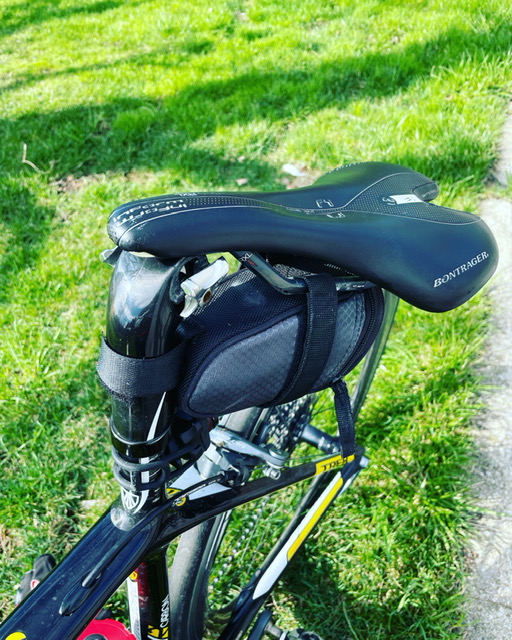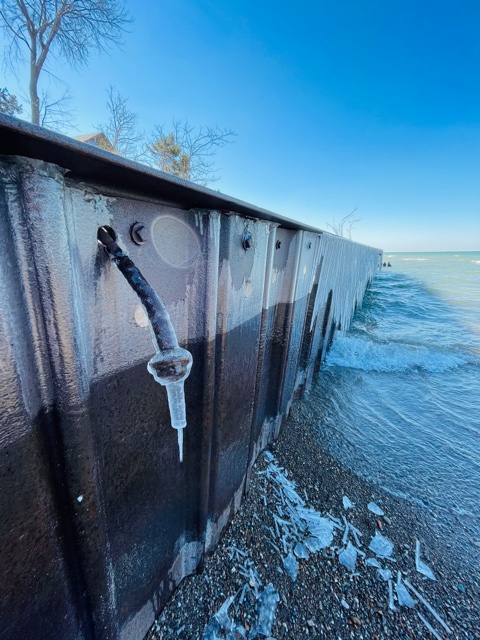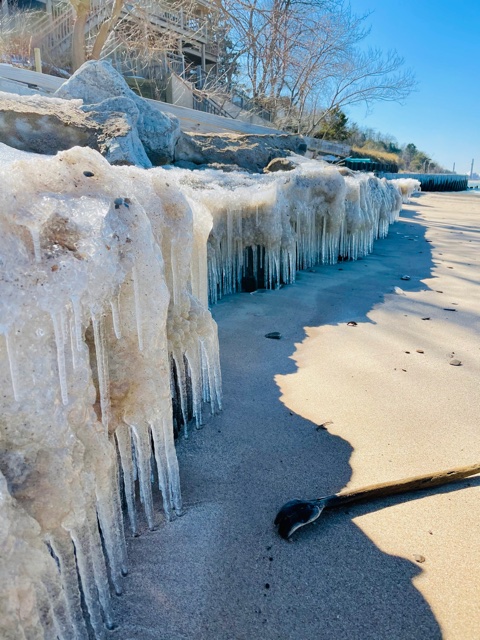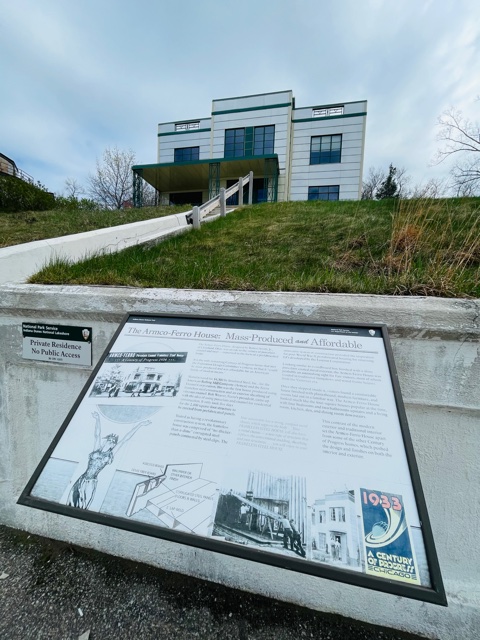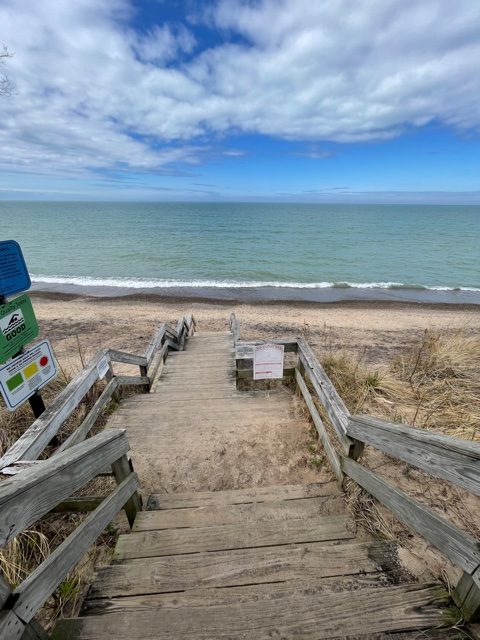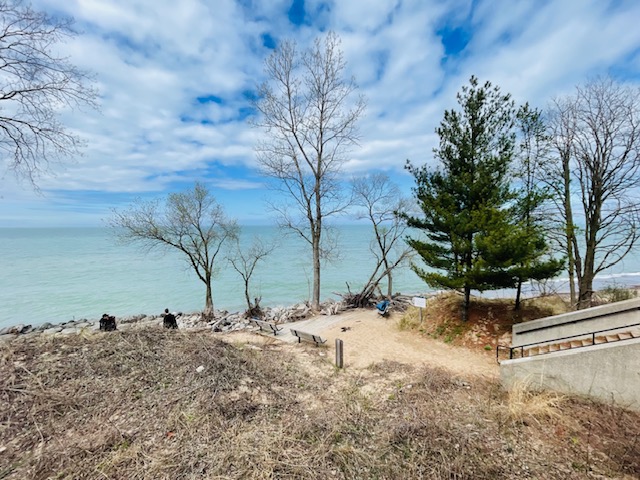
I love living so close to Lake Michigan. The Indiana Dunes National Lakeshore (which has recently become the Indiana Dunes National Park) has a magical quality to it. It literally looks different every time I visit it. Sometimes on a sunny summer day, the water will reflect the sky and be so blue that it looks like the Caribbean Sea. On a really clear fall day, Chicago is usually visible across the water. In addition, the rising and falling of the waves make the shoreline disappear and reappear. In the winter months, when the shelf ice forms, the lake is at its most majestic and mystical. Just one night of below zero temperatures can turn the sandy shore into an arctic playground, complete with ice caves and ice mountains. Along the protected lakeshore, there are the houses from the 1933 World’s Fair Exhibit, “The Houses of Tomorrow”. My favorite is the pink Florida House, which is pictured above. I snapped the picture on a recent bike ride. The trip to the beach from my house is almost exactly 100 kilometers (62 miles), and is one of my favorite weekend destinations.
But something sinister has been afoot on the lakeshore. In the last six years the water level of Lake Michigan has risen by three feet. While fluctuations of the water levels are not uncommon throughout history, the rising of the waters in the last six years is unprecedented. This is due, in part, to the rising temperatures of the lake and climate change. I’ve lived close to Lake Michigan since 1992, and it is most definitely not the beach that I took my boys to when they were little. Kemil Beach used to have a beach beyond the boardwalk,and large boulders surrounding the shelter. That portion of the beach has since disappeared. The boardwalk has been swallowed up by water, and the road that runs along the lakeshore was destroyed by the waves last summer. To save the road and the homes along the lakeshore, the National Park Service had to haul in tons of sand and rocks to rebuild the shore. It’s ironic that a large part of the National Park and protected lakeshore is not natural, but man made.
On March 2nd of this year, after we had a week of warmer temperatures, I decided to take my fatbike to the beach to see if the shore was still rideable. Because the temperatures were still close to freezing, I was hoping the sand would be frozen enough to ride on. I drove my fatbike to the Kemil Beach shelter and unloaded it, then rode the short distance down the road to get to the shore. It was an incredibly beautiful day, and the water was almost as blue as the sky.
When I first set out, I thought it was a mistake to have made the trip. The sand was soft and there was a lot of foot traffic, making the sand very difficult to push through. I ended up walking the bike down to the water. Once down close to the water, I got on the bike and was happy to see that the sand was hard enough to ride on. It didn’t last long however, as there is a large section of Kemil Beach where pebbles always wash to shore. It was almost impossible to ride through the pebbles, but I kept going. Once I got past this portion of the beach, the sand became hard packed and I found I could ride almost as fast as being on the road! This was exhilarating, and I hoped I could ride the the bike all the way to the steel mill, which is about 7 miles down the shoreline.
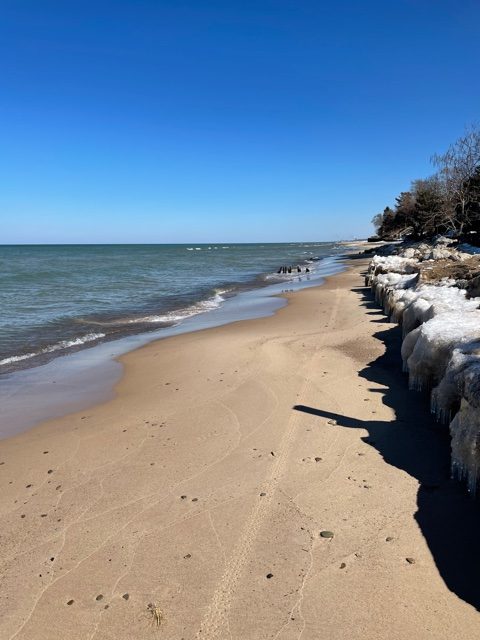
However, this was not to be. Once I got past the pavilion at the state park, the shore ran out shortly after Porter Beach. This portion of the beach used to be rideable, and it was possible to ride all the way to the mill. In the winter when the shelf ice forms, it’s still sometimes possible to make the trip. But on this day, since the shelf ice was gone, going any further was a no-go. Below are some pictures of the end of the line, where there was no way to get around the seawall.
So, I reluctantly turned around and headed back. At first I thought I might time the waves and be able to make it to the other side of the seawall before the next wave, then I decided it would not be wise to get wet at temperatures hovering around freezing. Although of course, Marc would have totally just kept going. Below is a picture of him forging ahead in close to the same spot a few years ago. The wooden planks he is riding around can be seen in the distance of the first picture above.
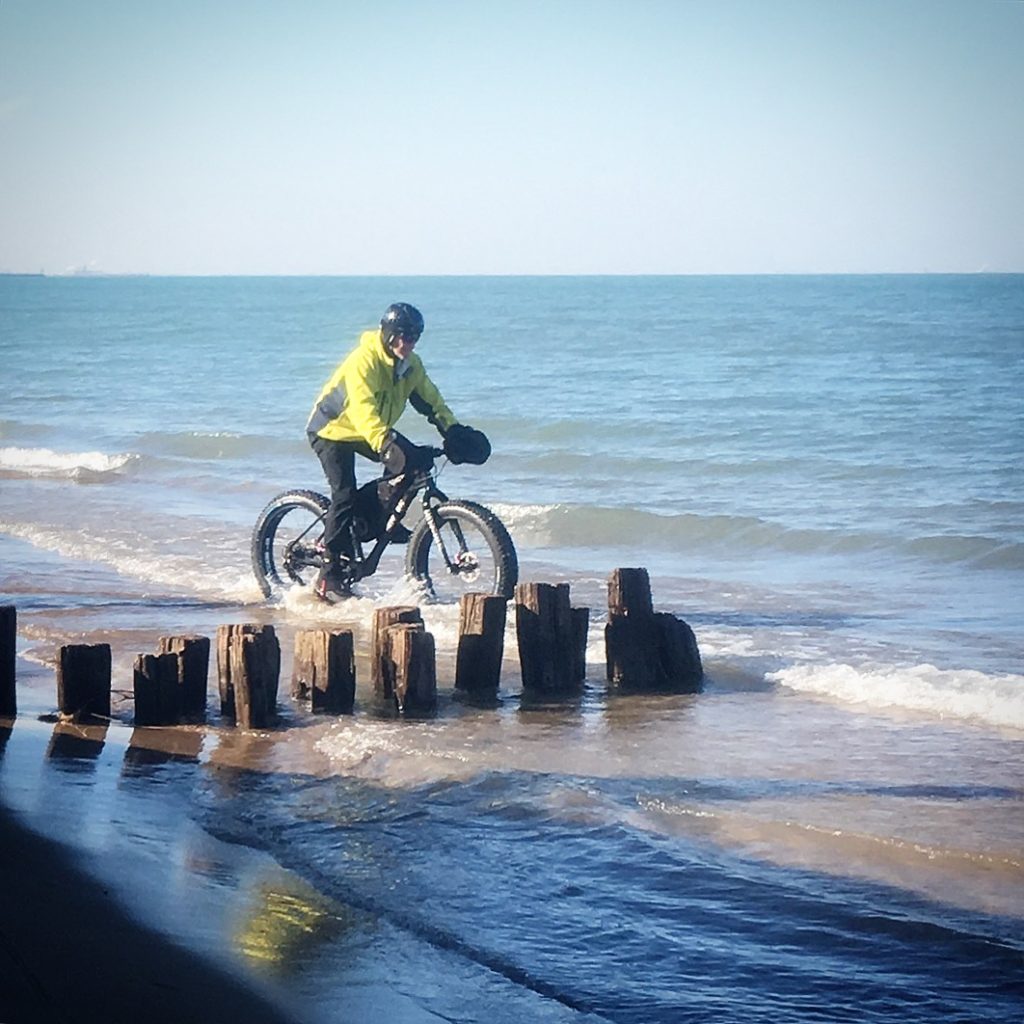
As I flew back down the shore to Kemil Beach, I was disappointed that I couldn’t have kept going. I decided that I would ride back to Kemil Beach, then back to the the Lakeshore Drive, and over to Central Beach. When I was almost to Kemil Beach I saw a fatbiker that I didn’t know walking his bike through the section of pebbles that were difficult to ride through. It looked like he was re-thinking his decision to try and ride the beach. I told him to not be discouraged and that the beach got really hard packed and fast in just a little while. He said thanks. It was strange to see someone on a fatbike that I didn’t know.
When I got back to Kemil Beach, I rode my bike as far as a could in the soft sand, then walked my bike up to the road. I then rode along the lakeshore road to the road that goes to Beverly Shores. It had been years since I had been to Central Beach, and I wanted to see if it was possible to ride the shore there. Central Beach, when the boys were little, was a beach that mostly only the locals knew about. You had to park your car in a small lot, then do a hike through the woods to get to it. Central Beach is known for its large sand dunes, and the boys used to sled down it with plastic sand sleds. Below is a picture of Central Beach from the end of the lakeshore road, which dead-ends on a waking path that leads to a cliff, with a view of the beach. I took this picture on another one of my bike rides.
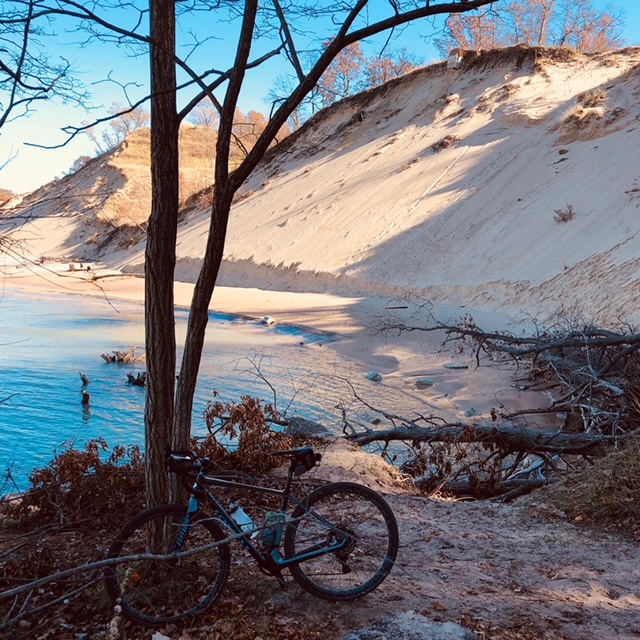
When I got to Central Beach, I took a road that has been blocked off to traffic, that leads straight to the beach (bypassing the parking lot and hike through the woods). There used to be a pass between the sand dunes that you could walk down, that led directly to the shore. I assumed I could still do that, although the last time I had been to Central Beach was about 15 years ago when my nephew Michael was a teenager.
I got to the sand at the end of the road and I dismounted my bike. I then started walking through the deep sand, thinking I was going to be able to walk down to the beach. I was totally shocked to see that the sand just ended, and I was on a cliff with the beach about thirty feet below. I was shocked and confused for a minute, and was trying to figure out where the beach had gone! I looked to the left and right, thinking there had to be some way to get down to the beach, but there wasn’t. The beach had completely eroded, and it appeared they had trucked in millions of pounds of sand and rocks to build out the cliff I was standing on. This must have been in an attempt to save the road and the bathrooms that are still there. I just stood there, completely shocked that the beach no longer existed. I was flooded with all of the memories of the boys swimming there. I stayed for a while and took pictures, although the pictures below don’t really show the height of the cliff I was standing on. My bike is lying at the edge of the cliff in several of the pictures.
As I rode back to my car, I couldn’t help but worry about the future of the beach. If the waters keep rising at the pace they have in the past six years, there is no way anyone can truck in enough sand to save it. It made me even more incredibly grateful to live so close to such a natural wonder, and to have the physical ability to enjoy it.
This year, spring in Northwest Indiana has come early. The months of March and April normally see cloudy skies and snow or freezing, cold rain everyday. The sun doesn’t typically shine on most days until May, and our growing season is much shorter than the southern parts of the state. This year, however there have been more sunny skies and warmer temperatures than I can ever remember. Because of this, most free weekends this spring I have taken a trip to the beach on my road bike or gravel bike. It is wonderful to have a destination, instead of riding the same country roads everyday, surrounded by nothing but cropless fields (and lots of wind!)
The last time I rode to the beach it was about 54 degrees with a north wind the entire trip. The sun was shining and the cloud formations were just amazing. I knew that once I got close to the lake the temperature would instantly drop by about 10 degrees, so I wore thermal gloves and a jacket. I took the long way to the beach, which was exactly 42 miles to this spot where I always love to stop and take a picture. The sky and the water were close to the same lovely shade of blue!

I sat on the stairs of this little pavilion in the picture and took some pictures of the beach. I thought about eating the peanut butter sandwich and carrots I had packed, because I was crazy hungry after riding 42 miles against the wind. Plus, I just wanted to look at the water and listen to my 70’s music on my headphones. However the north wind coming across the lake was so cold my hands were freezing without my gloves when I attempted to get the sandwich out of my backpack. So I decided to ride to the shelter down the road to see if it was a little bit warmer there. I sat on a bench in the sunshine when I got there and ate 1/2 of my sandwich. Whenever I pack food for a ride, I try to eat it in small bits. They say you only need about 120 to 180 calories an hour to sustain energy. Too much food in the stomach is like throwing a big log on a fire. It can smother the fire, but putting no wood on the fire can make it go out. So you have to eat. The trick is when I pack food, I try to eat a little bit every hour, instead of eating it all at once, so it is like little bits of kindling on the fire. I had eaten a nut bar at about mile 20.
As I sat and ate, I reminisced about taking to the boys to this beach when they were little. One Easter we even had an Easter egg hunt at this spot. The boardwalk and the beach are now gone due to the rising waters, as I had mentioned before. I have a picture of Andrew at age 2 sitting on the rocks of this beach. I thought of that as I snapped a picture. The beach used to extend for quite a distance after the rocks.
After I was done eating, I rode down the lakeshore and took some picture of the homes built for the 1933 “Homes of Tomorrow” Exhibition in Chicago for the World’s Fair “Century of Progress”. The houses were transported by barge across Lake Michigan and are now a part of the National Park. Private owners were able to work on restoring the houses in exchange for a lease to live in them. Some of the houses have been under restoration for years. In 1992 when I first moved to the county they were all abandoned and were falling apart. The only two completely restored are the Florida House and the prison-like house called the Wieboldt-Rostone house. It was designed by an architect in Lafayette, Indiana, who designed many buildings on the campus of Purdue University. It was made with Rostone slabs, an exciting new material in 1933 that was said to never need repairs. It has withstood the test of time very well, but it is not pretty!
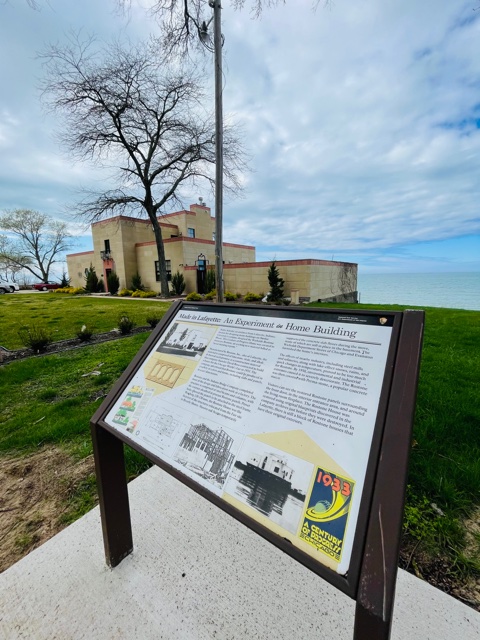
The Armco-Ferro House is a steel framed house with a porcelain enamel exterior (it’s the house on the right below). This too, is not an attractive house, but looks like it has held up well. To the left of it is the House of Tomorrow, which is the house that has suffered the most and is still under renovation.
Shortly after they were moved from Chicago across Lake Michigan by barge in 1933, this is what these two houses looked liked:
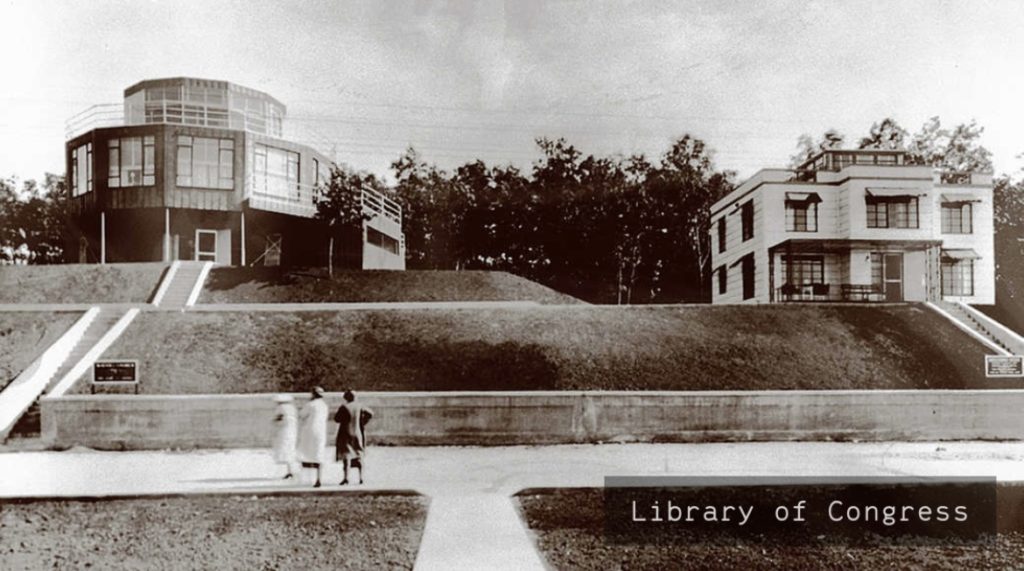
After I took a few more pictures of the beach, I was ready to head home because clouds had started to move in and the temperature kept dropping! I was looking very forward to the tailwind on the way home, and I figured the tailwind would keep me warm. It was not to be. I was so cold I was thinking there was no way I could make the 30 miles home without a heavier jacket. But, an amazing thing always happens once you get just about 5 or 10 miles past the beach. The clouds part and the sun shines and the temperature raise by about 10 to 15 degrees!
At mile 54, about 18 miles from home, I was enjoying a tailwind and a very fast downhill when I hit a bump and the seat of my bike came off! Luckily I wasn’t hurt, but I had to ride the bike for a mile to get to a safe place to pull over. Of course this was the day that I forgot my multi-purpose tool, so I had to call for a rescue from my bike mechanic and hubby, Marc. My old Trek has a seat post that accommodates seats with different rails than the ones that are on my bike seat. Mine are oval, and the Trek accommodates round ones. I knew the seat always needs tightened because of this, so it was kind of silly to forget my tool. The problem is that the only seat my butt can tolerate is the seat that is on the bike. So my mechanic showed up and fixed the seat, and I was on my way back home to ride another day!
